Abstract
Substrate integrated waveguide (SIW) technology that combines 3D and 2D structures has been successfully utilized due to its notable advantages, including in its application to H-plane horn antennas. As this type of antenna is commonly constructed on thin substrates, the E-plane radiation pattern is always wide, thereby limiting the achievable gain performance. In this work, we propose an approach that incorporates 3D printed horns on a prefabricated SIW H-plane horn antenna to successfully narrow the E-plane radiation pattern, thereby improving the gain performance. The proposed E-plane horn is designed at the aperture of the original H-plane horn, providing a smooth and continuous wave transition from the thin substrate to the end-fire direction. This approach improves the directional radiation performance significantly and reduces fabrication time and associated difficulties as the parasitic structures are simply attached to the SIW horn, without the requirement of redesigning or refabricating the original antenna. From 20 to 25 GHz, an optimized prototype shows excellent performance. At 22.7 GHz, it exhibits 35° and 33° for the E- and H-plane half-power beamwidths (HPBWs), with corresponding side-lobe levels (SLLs) of −23 dB and −15 dB. The present research reveals that the proposed design presents high feasibility and a reduced demand for high-precision manufacturing processes at a lower cost, concomitantly providing an effective means to further improve on the radiation characteristics.
1. Introduction
Substrate integrated waveguide (SIW) technology has attracted a significant level of attention due to its easy integration with planar circuit components, and a low-cost fabrication process [1]. In recent years, the application of microwave devices has become well developed [2,3,4,5]. Various antennas with an improved performance have been proposed and designed through the use of SIW technology to meet the different needs of large-capacity transmission [6,7,8,9]. Several SIW designs [7,8,9,10] have been accomplished with increased radiation and matching performance levels, specifically for directional antennas.
In terms of the gain improvement through radiation characteristics for the SIW H-plane horn antenna, various techniques have been developed aiming for a high directivity [10,11,12,13,14,15,16]. A simple approach of extending the dielectric loading to narrow the beam is proposed in [10], and further developed in [11] by reshaping the aperture through the printing metal. In [12], the tapered slots along the electric polarization are designed to narrow the E-plane pattern. Perhaps one major drawback is the bulky antenna size provided by multiple stacked printed circuit boards (PCBs) to ensure the wave propagation. More recently, a SIW H-plane horn antenna combined with a dipole array was proposed in [13], showing an improved radiation performance, including a 14 dBi gain and HPBWs of 44° and 32° in E- and H-planes at 20.5 GHz. However, this prototype fails to resolve the conflict between the antenna performance and the manufacturing feasibility when considering the fabrication difficulty.
Recently, the remarkable success of newly emerged 3D printing technology offered an effective platform for increased geometrical and material versatility [17]. Notable 3D printed antenna design examples have been implemented [18,19,20], showing that both a high radiation performance and a low fabrication cost can be simultaneously fulfilled. A 3D printed metallic Cassegrain antenna with a concave reflector [18] is presented for operation in the Ka-band. The measurements confirm a bandwidth of more than 40% and a gain of up to 23 dBi for five of the radiating elements. Another 3D printed polarizer, consisting of air and dielectric slabs to enhance the gain by increasing the directivity, is demonstrated in [20]. This antenna design achieves a 50% impedance bandwidth from 45 to 75 GHz, with a gain of up to 15 dBi. Based on these examples, 3D printing utilization has spurred our interest in the fabrication of such a design.
In general, for the SIW horn antennas fabricated on thin substrates, the improvement of gain is typically confined to the H-plane because of the inherent SIW structure, while only a few studies have been carried out for the improvement in E-plane performance with a complex design and high cost. To address these issues, we propose an innovative approach to further improve the radiation performance by narrowing the E-plane pattern. This is achieved by introducing two parasitic sets of E-plane horns to a pre-existing SIW H-plane horn antenna [11]. The horns are fabricated by multi-material fused deposition modeling (FDM) with a conductive nano copper wire (NCW) composite.
2. Antenna Design
The proposed antenna, with 3D printed E-plane horns, is shown in Figure 1. The 3D printed horns (red parts) are attached symmetrically at the two main radiation sources, the antenna aperture, and the end with the dielectric loading, along the propagation direction. A supporting structure (white part) is printed concomitantly using polylactic acid (PLA), following the same shape of the horn. The geometrical parameters and the dimensions are illustrated in Figure 2 and Table 1.
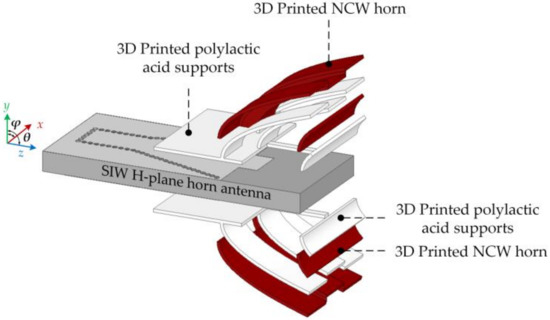
Figure 1.
The proposed antenna where the 3D printed NCW horns and their dielectric supports two sides of the SIW antenna.
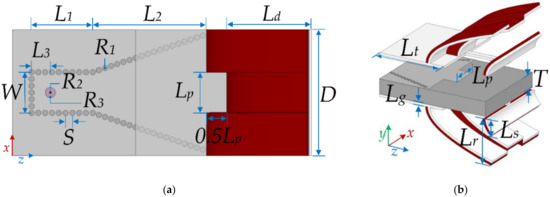
Figure 2.
The proposed SIW horn antenna geometry with labeled parameters. (a) Top view; (b) perspective view of the parasitic E-plane horn.

Table 1.
Dimensions of the proposed antenna (values are in millimeters).
The SIW antenna is designed using a single layer of Taconic RF45, with a dielectric constant of εr = 5.1 and a thickness of T = 3.15 mm. The radius R1 of the metal vias and the distance S between them are calculated based on Equations (1) and (2), and the design rules outlined in [21,22], thereby ensuring minimum leakage. It should be noted that due to the gap between the inserted metal vias in the substrate, traditional SIW technology is suitable for designing the antenna with the given TE mode. The width and length of the SIW feeding are labeled W and L1, where the coaxial feed is located a length L3 away from the SIW back wall. The radii of the transition pin and the outer conductor are R2 and R3. The rectangular patches (0.5 Lp by Lp), which represent the extension of the top and the bottom metal cladding, lie on the dielectric loading of length Ld. In terms of the printed structures, the width of the horn and their supporting structures hold the same width D as the antenna aperture and the same dielectric loading. The optimized vertical openings of the horns are labeled Lr and Ls, respectively. The thickness of the dielectric supports is Lg, and the length is Lt.
Our design idea is inspired by the work in [14], where an elliptical SIW H-plane horn, fed by a 90° coaxial waveguide, is proposed to minimize the length of the traditional H-plane horn. In our case, as the aim is to improve the directivity of the SIW H-plane horn antenna by narrowing the E-plane radiation pattern [23], the surface of the horn is set parallel to the x-axis. This is because when the H-plane horn is excited by the SIW fundamental mode TE10, the antenna aperture can be treated as a magnetic current source [24]. Thus, when using a thin substrate, the antenna aperture is closer to an ideal line source for the thickness of the substrates, which is much smaller than the wavelength.
In terms of the horn shape, our E-plane horns at the antenna aperture and at the end of the dielectric extension in the yoz plane follow the parabola function shown in Equation (3), where f is the focal length and optimized to 1.4 mm. The proposed E-plane horns provide the following advantages: (i) a smooth transition for the electric field radiating from the antenna aperture, contributing to narrowing the E-plane pattern; (ii) they reduce the backward radiation located around the three-quarter wavelength for the radiation at the end of dielectric loading.
3. The Improvements by the 3D Printed Horns
3.1. Comparative Field Analysis
In this section, we confirm the benefits of the 3D printed E-plane horns by comparing the simulated E-plane field of three investigated antennas, the original antenna without the 3D printed parasitic horns, and the original antennas with parabola and flat horns in the same opening. The simulation is conducted at the designed frequency of 22.7 GHz.
The field distributions in the E-plane, at the same frequency, are shown in Figure 3a–c. It is evident that the field distribution of the original antenna is close to the omnidirectional propagation because the electric field at the aperture is compressed more than the wavelength, which results in a wide E-plane beamwidth, as shown in Figure 4a. On the other hand, compared with the flat horn, the wave at the horn aperture of the parabola case is closer to the plane wave, contributing to a narrower E-plane HPBW of around 34°. This is because the parabola horn provides a longer path and smoother transition for the wave near the horn’s edge, thereby compensating for the phase difference. Judging from the H-plane patterns in Figure 4b, the parabola horn can also maintain the narrow HPBW at 27° because there is no phase-shift modification in this plane.

Figure 3.
Simulated E-plane field distributions and radiation patterns of three investigated antennas at 22.7 GHz. (a) Original antenna; (b) parabola horn; (c) flat horn.
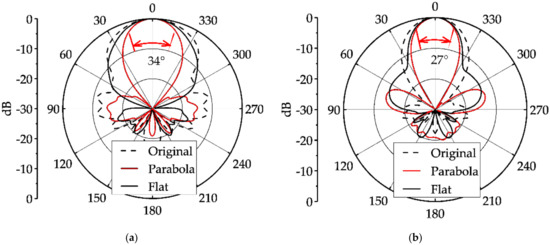
Figure 4.
Simulated radiation patterns of three investigated antennas at 22.7 GHz. (a) E-plane; (b) H-plane.
3.2. The Impact of the 3D Print Materials
3.2.1. The Nano Copper Wire (NCW) Based Conductors
Regardless of the matching that occurs between the antenna and the open space, loss in the material contributes to antenna gain degradation [25,26]. The average power Pt(avg) dissipated in the conductor, as shown in (1), indicates a strong dependence on the conductivity σ, where T is the transmission coefficient, α is the attenuation constant, and E0 is the amplitude. Thus, as the proposed horns are fabricated by a relatively lossy material filled with NCW, the impact of the filler’s conductivity on radiation efficiency must be accounted for.
The conductive NCW for the filament is chosen for the fabrication because, compared to the carbon black (CB) and carbon nanotubes (CNT), it provides a relatively higher conductivity. According to the manufacturer, the highest level of conductivity is around 1.6 × 104 S/m, but it drops with the variation of the raster angle orientation, the extrusion temperature, and the flow rate during the printing process.
The simulated radiation characteristics vs. the conductivity σ of the NCW from 0 to 1.6 × 104 S/m is shown in Figure 5. In the simulation, copper (5.96 × 107 S/m) is set as a reference material. Furthermore, the simulated radiation efficiency of the original antenna (Figure 3a) is added, indicating the impact of the loss, when using NCW, on the radiation efficiency. A supporting structure (see Figure 2) following the horn shape constructed from PLA is also considered in the simulation. It can be seen that, for the conductivity in a relatively worse case, from 1 × 103 to 7 × 103 S/m, the power loss in the NCW structure leads to a reduction in radiation efficiency, from around 11.4% to 2.4%, compared with the copper.
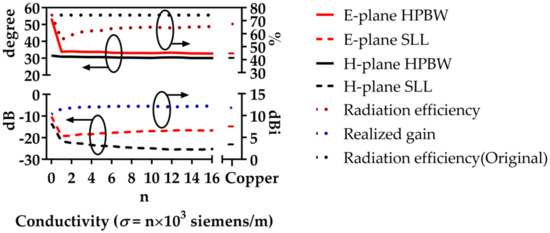
Figure 5.
The impacts on the radiation characteristics of the conductivity of the NCW horn.
The most significant finding from the results is that when the NCW conductivity is below the ideal case (from 7 × 103 to 1.6 × 104 S/m), the proposed horn enables satisfactory radiation performance cf. the copper. For example, when σ = 7 × 103 S/m, the HPBW in the E-plane only has a 0.06° increase, while the corresponding SLL has a 3.05 dB reduction, which sustains a wide-realized gain of around 12.14 dBi. Even for the worst cases of conductivity, for example at 1 × 103 S/m, the HPBWs in both the E- and the H-plane only have a 0.8° and 0.2° increase compared to the copper, which only has a 0.3 dBi decrease in the realized gain. These findings show that the proposed approach offers an easy option for improving SIW H-plane performance due to its low-cost fabrication and a high availability of the material.
The influences of surface roughness of the finished structure using FDM include extrusion temperature, print speed, wall thickness, and print orientation. A recent 3D print reflector antenna presented in [27] demonstrates that such a roughness influences the total loss at less than 0.1 dB at THz frequencies. Therefore, with regard to the frequency in our work, the total loss caused by the roughness is expected to be very low. This loss could be further reduced by using a smooth surface technique [28].
3.2.2. The Polylactic Acid (PLA) Dielectric
A parameter study of the PLA supporting material is also conducted to determine its impact on radiation. This is because the measured dielectric constant εr and the loss tangent of PLA vary at different frequencies. Generally, the measurement results in [25] and [26] report that the dielectric constant of the PLA drops from 3.5 to 2.7 as the frequency increases from 9 to 40 GHz. Given our printing accuracy, to control and minimize the power loss in the supporting structure, we perform the simulation for the dielectric constant εr of the support, shown in Figure 6a. Furthermore, according to the measurement in [25] and [26], as the loss tangent of the PLA has a small shift (±0.2 × 10−3) when given a wide frequency range from 9 to 40 GHz, we fix the loss tangent to 0.014, and a simulation result for εr = 3.4 and tanδ = 0 is considered as a reference. From the results, compared with the reference, the maximum difference of radiation efficiency and realized gain are shown to be around 4% and 0.6 dBi. Regarding the normalized radiation characteristics, as the dielectric constant increases, the narrow E- and H-plane HPWBs are maintained at around 34° and 31°, with the corresponding SLLs at around −19 dB and −23 dB, respectively.
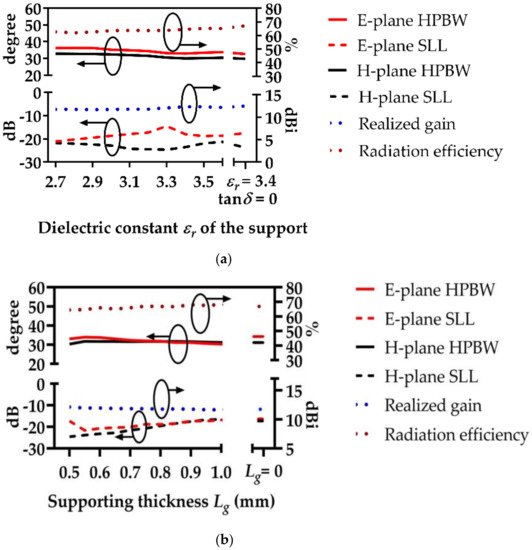
Figure 6.
The study of the supporting material PLA on antenna performance. (a) The impact of the supports’ dielectric constant; (b) the impact of the supporting thickness Lg.
The impact of the thickness Lg of the supporting structure on radiation performance is investigated at 22.7 GHz in Figure 6b, for Lg ranging from 0.5mm to 1mm. The case in which the NCW horn is directly contacting the metal plate of the substrate (Lg = 0 mm) is considered as a reference. When compared to this reference, the maximum difference in the radiation efficiency is found to be about 2.4% for lengths Lg ≥ 0.5 mm. Regarding the radiation pattern and realized gain, the beam widths in both planes keep stable at around 32° in E-plane and 31° in H-plane, leading to a flat gain of around 12 dBi. These results show that the thickness of the structure does not have a significant impact on the improvement of the radiation pattern that can be achieved.
4. Antenna Fabrication and Measurement
The antenna structure with dimensions as given in Table 1 is fabricated using the consumer-grade 3D printer ‘Ultimaker 3’, shown in Figure 7a,b. As the bandwidth (BW) improvement is not the focus in this work, the entire antenna is fed directly by a coaxial connector (Huber + Suhner’s PC 3.5-mm) with a transition pin (73-Z-0-0-168) recognized for its narrow BW.
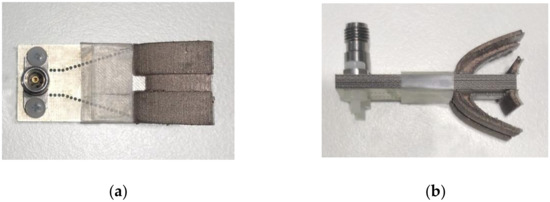
Figure 7.
Fabricated prototype. (a) Top view; (b) side view.
4.1. The Radiation Characteristics
A good agreement between the simulated and measured radiation patterns of the proposed antenna, in normalized values, is shown in Figure 8a,b. Compared to the original antenna, the HPBW in the E-plane is narrowed by 17°. In terms of the SLL, a reduction by about 13 dB in the E-plane is reached, while there is only a 0.6 dB increase in the H-plane. An improvement of around 5.8 dB in the front-to-back ratio (FTBR) is also achieved. Compared to the simulation results, the H-plane has a 2.3° wider HPBW and 2.6 dB higher SLL due to the imperfect finishing structure, and a shape change of the main lobe of around 30° ≤ θ ≤ 90° (270° ≤ θ ≤ 330°). This difference could be attributed to a possible uncertainty in the printing accuracy, the extrusion temperature, or the fabricated speed, leading to insufficient mobility and an uneven volume of the extruded wire. Further, FDM 3D printing also inherently introduces rough surfaces, leading to the path difference of the waves, and the phase error.
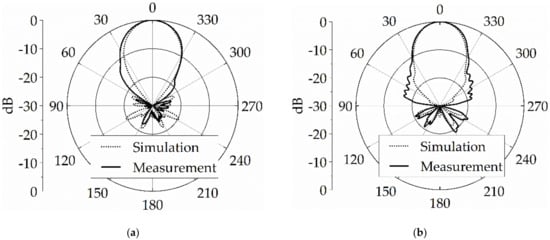
Figure 8.
Measured and simulated pattern at 22.7 GHz; (a) E-plane; (b) H-plane.
The antenna prototype is measured at multiple frequencies from 20 to 25 GHz. Figure 9 shows that in this frequency range, the proposed antenna provides stable and narrow radiation patterns. More specifically, from 22 to 24 GHz, the E- and H-plane beamwidths continue reducing while the low E-plane SLLs below −20 dB are maintained. The FTBR increases above 25 dB at around 23 GHz as a result of the wavelength variation. The simulated radiation efficiency, covering the measured frequency band, is plotted as a reference. At the designed frequency of 22.7 GHz, the radiation efficiency is around 68%. The measurement results indicate that to improve the radiation performance of the SIW H-plane horn antenna at multiple frequencies, the proposed antenna offers an easy fabrication solution cf. the high cost and precision techniques of the PCB manufacturing.
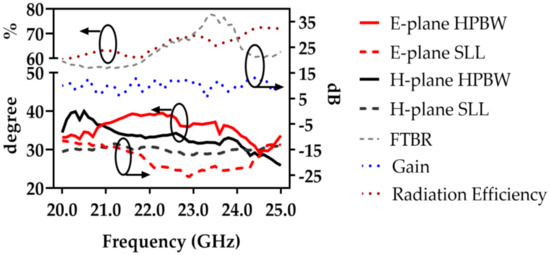
Figure 9.
The measured radiation characteristics from 20 to 25 GHz.
4.2. The Reflection Coefficient |S11|
The reflection coefficient |S11| of the proposed antenna, shown in Figure 10, is measured with an E8364C PNA network analyzer. The measurement results agree well with the simulation for the proposed antenna, which is directly fed by the coaxial connector (50 Ω port impedance) with a transition pin. A relative impedance BW of about 5.3% (21.8 to 23.0 GHz) for |S11| ≤ −10 dB is measured. To show that the narrow BW is mainly due to the feeding technique, the proposed antenna, fed by a waveguide (wave port excitation with TE10 mode in the HFSS) with a pair of tuning vias, is simulated, as shown in Figure 10. Through the use of waveguide feeding into the same panel, a relative impedance BW of about 15.3% (22.1 to 25.6 GHz) for |S11| ≤ −10 dB can be achieved.

Figure 10.
The reflection coefficient |S11| of the proposed antenna using different feedings.
In this section, the results of the radiation characteristics, and the matching, provide further support for the excellent performance of the proposed antenna in maintaining the stable radiation within the wideband.
5. Discussion
A summary of recent SIW H-plane horn antenna designs is shown in Table 2. All results are selected based on the measurement results of a single antenna element on one single PCB layer with the best radiation performance extracted for the wideband designs. In terms of the feeding technique and bandwidth, [11,12,13,24] show that such a class of antennas provides narrow bandwidth when a 90-degree coaxial to SIW transition is used. On the contrary, the waveguide transition implemented in [29,30] shows a wider bandwidth.

Table 2.
Summary of recent works.
Regarding the radiation pattern and gain enhancement, it can be concluded that for SIW H-plane horn antennas, there are many ways to improve H-plane performance as plane modification is easy to realize using the traditional PCB fabrication process. The work presented in [14,24] reveals that the gain enhancement is limited by the wide E-plane pattern. Although the designs in [13,32] attempt to improve E-plane performance, they require either a high-precision technique or a complex design process, and the radiation patterns are unstable at multiple frequencies. Compared with the predesigned SIW H-plane horn antenna [11], the proposed NCW horn offers an enhanced gain of about 1.1 dB and an increased BW of around 3.3%. It is worth emphasizing that the parasitic E-plane horn maintains a good H-plane performance while substantially narrowing the E-plane pattern by about 17° of the HPBW and lowering the SLL by about −13 dB. A further improvement in these radiation characteristics is expected to be achieved by utilizing a more conductive 3D printing material.
Due to these reasons, to extend the use of SIW H-plane horn antennas, our proposed structure combined with 3D printed horns offers a better solution for the benefits of superior radiation performance and design simplicity.
6. Conclusions
In this paper, we concentrate our attention on gain enhancement by narrowing the E-plane pattern of the SIW H-plane horn antenna with a simple design. To achieve this, a 3D printed parabola horn is attached to a pre-designed antenna. Based on the analysis and simulations, the optimized structures are fabricated by consumer-grade multi-material FDM printing, using conductive material NCW composite and PLA. According to the measurement results, at the designed frequency, it offers a gain of 12 dBi with an E-plane HPBW at 35° and SLL at −23 dB, which prove to be 17° narrower and 13 dB lower than the pre-designed antenna. The experimental work and findings presented here provide a significant contribution to research on their low-cost fabrication and easy design, together with the achievement of a superior radiation performance.
Author Contributions
Conceptualization, S.H. and K.Y.C.; investigation, S.H. and Y.W.; writing—original draft preparation, Y.W. and S.H.; writing—review and editing, K.Y.C. and R.R.; supervision, R.R. All authors have read and agreed to the published version of the manuscript.
Funding
This research received no external funding.
Data Availability Statement
The data presented in this study are available on request from the first author.
Acknowledgments
The authors would like to thank Ken Smart from CSIRO for strongly supporting the antenna measurements.
Conflicts of Interest
The authors declare no conflict of interest.
References
- Bozzi, M.; Georgiadis, A.; Wu, K. Review of substrate-integrated waveguide circuits and antennas. IET Microw. Antennas Propag. 2011, 5, 909–920. [Google Scholar] [CrossRef]
- Althuwayb, A.A. MTM- and SIW-Inspired Bowtie Antenna Loaded with AMC for 5G mm-Wave Applications. Int. J. Antennas Propag. 2021, 2021, 6658819. [Google Scholar] [CrossRef]
- Yang, Y.; Cai, Y.; Chan, K.Y.; Ramer, R.; Guo, Y.J. MEMS-loaded millimeter wave frequency reconfigurable quasi-Yagi dipole antenna. Asia-Pac. Microw. Conf. Proc. APMC 2011, 1318–1321, 6174002. [Google Scholar]
- Chan, K.Y.; Daneshmand, M.; Mansour, R.R.; Ramer, R. Novel beam design for compact RF MEMS series switches. Asia-Pac. Microw. Conf. Proc. APMC 2007, 1257, 4554572. [Google Scholar]
- Afzal, M.U.; Matekovits, L.; Esselle, K.P.; Lalbakhsh, A. Beam-Scanning Antenna Based on Near-Electric Field Phase Transformation and Refraction of Electromagnetic Wave Through Dielectric Structures. IEEE Access 2020, 8, 199242–199253. [Google Scholar] [CrossRef]
- Althuwayb, A.A. Enhanced radiation gain and efficiency of a metamaterial inspired wideband microstrip antenna using substrate integrated waveguide technology for sub-6 GHz wireless communication systems. Microw. Opt. Technol. Lett. 2021, 63, 1892–1898. [Google Scholar] [CrossRef]
- Dong, Y.; Itoh, T. Miniaturized substrate integrated waveguide slot antennas based on negative order resonance. IEEE Trans. Antennas Propag. 2010, 58, 3856–3864. [Google Scholar] [CrossRef]
- Gu, Z.; Wu, X.H.; Zhang, Q. Substrate-integrated E-plane waveguide horn antenna and antenna array. IEEE Trans. Antennas Propag. 2018, 66, 2382–2391. [Google Scholar] [CrossRef]
- Bayat-Makou, N.; Kishk, A.A. Substrate integrated horn antenna with uniform aperture distribution. IEEE Trans. Antennas Propag. 2017, 65, 514–520. [Google Scholar] [CrossRef]
- Wang, H.; Fang, D.G.; Zhang, B.; Che, W.Q. Dielectric loaded substrate integrated waveguide (SIW) H-plane horn antennas. IEEE Trans. Antennas Propag. 2010, 58, 640–647. [Google Scholar] [CrossRef]
- Gong, L.; Chan, K.Y.; Ramer, R. Substrate Integrated Waveguide H-Plane Horn Antenna with Improved Front-to-Back Ratio and Reduced Sidelobe Level. IEEE Antennas Wireless Propag. Lett. 2016, 15, 1835–1938. [Google Scholar] [CrossRef]
- Iigusa, K.; Li, K.; Sato, K.; Harada, H. Gain Enhancement of H-Plane Sectoral Post-Wall Horn Antenna by Connecting Tapered Slots for Millimeter-Wave Communication. IEEE Trans. Antennas Propag. 2012, 60, 5548–5556. [Google Scholar] [CrossRef]
- Jamshidi-Zarmehri, H.; Neshati, M.H. Design and Development of High-Gain SIW H-Plane Horn Antenna Loaded With Waveguide, Dipole Array, and Reflector Nails Using Thin Substrate. IEEE Trans. Antennas Propag. 2019, 67, 2813–2818. [Google Scholar] [CrossRef]
- Esquius-Morote, M.; Fuchs, B.; Zurcher, J.; Mosig, J.R. Novel thin and compact H-plane SIW horn antenna. IEEE Trans. Antennas Propag. 2013, 61, 2911–2920. [Google Scholar] [CrossRef] [Green Version]
- Huang, S.; Chan, K.Y.; Fu, Y.; Ramer, R. Dielectric-loaded substrate integrated waveguide H-plane horn antenna with embedded air cavity. IET Microw. Antennas Propag. 2021, 15, 154–162. [Google Scholar] [CrossRef]
- Huang, S.; Chan, K.Y.; Ramer, R. Dielectric-Loaded SIW H-Plane Horn Antenna With Gradient Air Slots. IEEE Antennas Wirel. Propag. Lett. 2020, 20, 43–47. [Google Scholar] [CrossRef]
- Chan, K.Y.; Ramer, R.; Sorrentino, R. Low-Cost Ku-Band Waveguide Devices Using 3-D Printing and Liquid Metal Filling. IEEE Trans. Microw. Theory Tech. 2018, 66, 3993–4001. [Google Scholar] [CrossRef]
- Bi, Y.; Li, Y.; Wang, J. 3D-Printed Wideband Cassegrain Antenna with a Concave Sub-Reflector for 5G Millimeter-Wave Two-Dimensional Multibeam Applications. IEEE Trans. Antennas Propag. 2020, 68, 4362–4371. [Google Scholar] [CrossRef]
- Li, Y.; Lei, G.; Wang, J.; Da, S.; Cao, D.; Wang, J.; Liu, Y. 3-D printed high-gain wideband waveguide fed horn antenna arrays for millimeter-wave applications. IEEE Trans. Antennas Propag. 2019, 67, 2868–2877. [Google Scholar] [CrossRef]
- Wang, K.X.; Wong, H. A wideband millimeter-wave circularly polarized antenna with 3-D printed polarizer. IEEE Trans. Antennas Propag. 2017, 65, 1038–1046. [Google Scholar] [CrossRef]
- Kordiboroujeni, Z.; Bornemann, J. Designing the width of substrate integrated waveguide structures. IEEE Microw. Wirel. Compon. Lett. 2013, 23, 518–520. [Google Scholar] [CrossRef]
- Xu, F.; Wu, K. Guided-wave and leakage characteristics of substrate integrated waveguide. IEEE Trans. Microw. Theory Techn. 2005, 53, 66–73. [Google Scholar]
- Balanis, C.A. Antenna Theory: Analysis and Design, 4th ed.; John Wiley & Sons: Hoboken, NJ, USA, 2016; ISBN 978-1118642061. [Google Scholar]
- Luo, Y.; Bornemann, J. Substrate integrated waveguide horn antenna on thin substrate with back-lobe suppression and its application to arrays. IEEE Antennas Wireless Propag. Lett. 2017, 16, 2622–2625. [Google Scholar] [CrossRef]
- Felício, J.M.; Fernandes, C.A.; Costa, J.R. Complex permittivity and anisotropy measurement of 3D-printed PLA at microwaves and millimeter-waves. In Proceedings of the 22nd International Conference on Applied Electromagnetics and Communications (ICECOM), Dubrovnik, Croatia, 15 September 2016. [Google Scholar]
- Huber, E.; Mirzaee, M.; Bjorgaard, J.; Hoyackm, M.; Noghanian, S.; Chang, I. Dielectric property measurement of PLA. In Proceedings of the IEEE International Conference on Electro Information Technology (EIT), Grand Forks, ND, USA, 7 May 2016. [Google Scholar]
- Adibelli, S.; Juyal, P.; Zajic, A. On the Surface Roughness and Smoothing in the 3D Printed THz Reflectors. IEEE Int. Symp. Antennas Propag. USNC-URSI Radio Sci. Meet. 2019, 15, 593–594. [Google Scholar]
- Sung-Uk, Z.; Jonghyeuk, H.; Hyun-Wook, K.; Byoung-Chul, S. Thermo-mechanical properties of ABS parts fabricated by fused deposition modeling and vapor smoothing. Int. Conf. Therm. Mech. Multi-Phys. Simul. Exp. Microelectron. Microsyst. 2017, 6, 7926222. [Google Scholar]
- Cai, Y.; Qian, Z.; Zhang, Y.S.; Cao, W.Q. A compact wideband SIW-fed dielectric antenna with end-fire radiation pattern. IEEE Trans. Antennas Propag. 2016, 64, 1502–1507. [Google Scholar] [CrossRef]
- Park, W.B.; Lee, J.M.; Lee, S.; Park, Y.M.; Hwang, K.C. A 18–40 GHz Substrate Integrated Waveguide H-Plane Horn Antenna. IEEE Trans. Antennas Propag. 2018, 66, 6322–6327. [Google Scholar] [CrossRef]
- Wang, L.; Yin, X.X.; Li, S.L.; Zhao, H.X.; Liu, L.L.; Zhang, M. Phase corrected substrate integrated waveguide h-plane horn antenna with embedded metal-via arrays. IEEE Trans. Antennas Propag. 2014, 62, 1854–1861. [Google Scholar] [CrossRef]
- Cai, Y.; Qian, Z.P.; Zhang, Y.S.; Jin, J.; Cao, W.Q. Bandwidth enhancement of SIW horn antenna loaded with air-via perforated dielectric slab. IEEE Antennas Wirel. Propag. Lett. 2014, 13, 571–574. [Google Scholar]
Publisher’s Note: MDPI stays neutral with regard to jurisdictional claims in published maps and institutional affiliations. |
© 2021 by the authors. Licensee MDPI, Basel, Switzerland. This article is an open access article distributed under the terms and conditions of the Creative Commons Attribution (CC BY) license (https://creativecommons.org/licenses/by/4.0/).